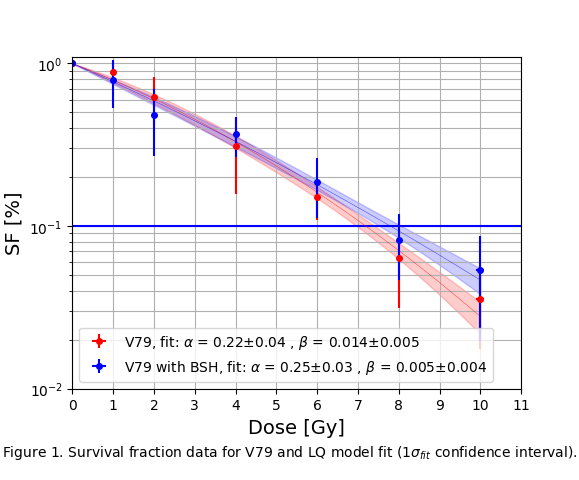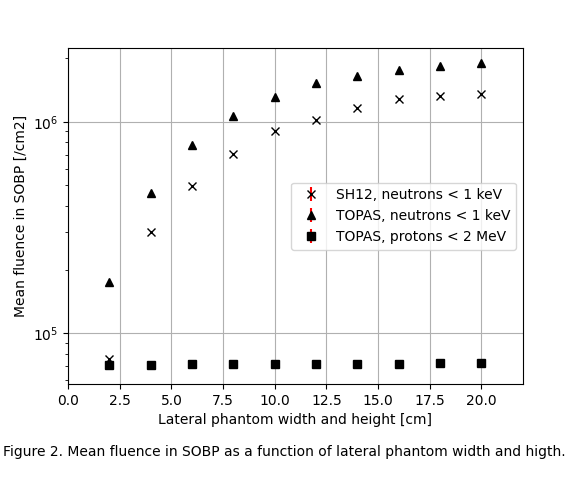Uncovering Proton Boron Capture Therapy: In-vitro Cell Irradiation and Monte Carlo Simulations
Villads Lundsteen Jacobsen,
Denmark
PO-2227
Abstract
Uncovering Proton Boron Capture Therapy: In-vitro Cell Irradiation and Monte Carlo Simulations
Authors: Villads Lundsteen Jacobsen1,4, Jacob G. Johansen1, Brita Singers Sørensen2, Hans O. U. Fynbo3, Mateusz Sitarz1, Anders T. Frederiksen2, Niels Bassler1,4
1Aarhus University Hospital, Danish Centre for Particle Therapy, Aarhus, Denmark; 2Aarhus University Hospital, Department of Experimental Clinical Oncology, Aarhus, Denmark; 3Aarhus University, Department of Physics and Astronomy, Aarhus, Denmark; 4Aarhus University, Department of Clinical Medicine, Aarhus, Denmark
Show Affiliations
Hide Affiliations
Purpose or Objective
In 2018, an enhanced relative biological effect (RBE) was reported when DU-145 prostate cancer cells had been exposed to sodium borocaptate (BSH) prior to irradiation with protons [1]. The increased RBE was hypothesised to stem from the three-alpha decay resulting from p+11B reaction. However, Monte Carlo simulation studies predict only very few additional alpha-particles stemming from the 11B reaction, which led to the hypothesis that other unknown mechanisms may be at work. In this study, we present both data from cell experiments trying to reproduce the biological effect and a Monte Carlo study on the reaction probability of both the p+11B and n+10B reaction channel, since both isotopes are present in the BSH in [1].
Material and Methods
Cell culture flasks were placed in a water tank in the middle of the SOBP. Cultures of the V79 cell line were irradiated with a 9x9 cm² uniform field, with the SOBP ranging from 6-9 cm. Cell survival curves were produced at 6 dose points ranging from 1-10 Gy with 6 control flasks. Each dose point consisted of 3 biological replicates, either with or without BSH enriched (0.17 µg/ml) medium.
Furthermore, we simulated the same proton field, irradiating a water phantom using TOPAS and SHIELD-HIT12A Monte Carlo particle transport codes. Cell culture flask was positioned in the simulated water tank containing medium with natural boron. We calculated the yield of different boron nuclear reactions, fluence of relevant particles and how they change depending on the geometry of the simulated setup and choice of physics software.
Results
No statistical significance between the regular and BSH exposed cells was observed in the survival curves, fig. 1. However, an apparent BSH toxicity affected the colony growth and plating efficiency. The BSH component was analyzed and significant amounts of the toxic BSSH dimer was present, even though the compound was stored in protective gas. A photon (6 MV linac) reference experiment further indicated BSH toxicity, but no radiosensitization. MC simulations show the n+10B capture reaction produces a factor of 177 +/-24 more high-LET particles than the originally proposed p+11B reaction. By varying the phantom (fig. 2) and field it was found that the fluence of low energy neutrons needed for the 10B reaction can increase/decrease up to two orders of magnitude. The conflicting results in published work prior to this study could attribute to the fact that too small phantom and field s were simulated which resulted in an underestimation of low energy neutron fluence in the proton beam of 1-3 orders of magnitude.


Conclusion
No enhanced RBE was observed for natural BSH exposed V79 cells when irradiated with protons. However, should nuclear reactions be the main mechanism of the previously postulated increase in RBE, then the n+10B would be the main contributor to production of high-LET particles, rather than the p+11B reaction.
[1] - Cirrone et al., Sci.rep 8; 2018